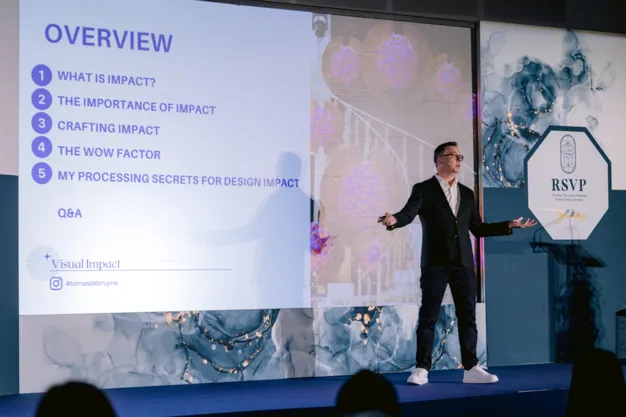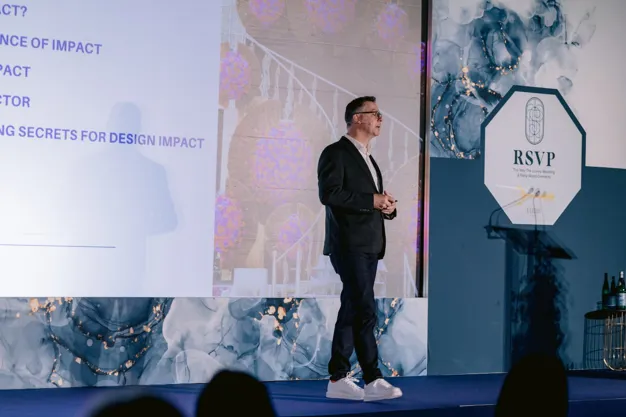Transitioning to the autumnal RSVP meeting in Venice, Tomas De Bruyne's presentation takes center stage. His narrative, woven around the profound concept of impact in design, particularly focusing on the nuanced facets of visual impact, calls for an exploration into the core of impactful design, the significance of captivating designs, and the nuances of making one's work resonate autonomously.
He emphasizes a staggering statistic, asserting that nearly 90% of designs elude notice daily, primarily due to a deficiency in visual impact. The immediacy of forming impressions compounds the stakes, with a mere 50 milliseconds required for users to formulate an opinion about a design. Visual impact, as Tomas De Bruyne defines it, is the indomitable force capable of arresting attention, imparting instantaneous messages, and etching enduring impressions.

The intricacies of impact are dissected, revealing it as a multifaceted construct. It encompasses an orchestration of elements—movement, color, size, and sound—that converge to resonate with the inner essence of the viewer. In this symphony of components, each element plays a distinct role: movement seizes attention, color invokes emotions, size begets physical impact, and sound enhances the sensory experience.
A dichotomy within impact—passive and active is introduced. Passive impact, characterized by depth, operates at a subdued level, while active impact exerts direct and high-powered influence. Both contribute a distinctive veneer to designs, elevating them beyond the mundane and rendering them unforgettable. The narrative segues into a personal anecdote from Tomas, drawing wisdom from an esteemed Indian wedding planner. The council advocates for an intentional imbalance between aesthetics and finances, urging the delivery of heightened aesthetic value relative to expenditure. This counsel, resonating with Tomas De Bruyne in all of his large-scale events, informs his decision-making paradigm.
This insight sheds light on the intrinsic challenge of creating impact on a design level, particularly when faced with resource constraints. A vivid example is presented, wherein a stunning interior compensates for a limited flower budget, epitomizing the fusion of creativity and fiscal pragmatism. The discourse expands to encompass the conceptualization of unique events when Tomas draws a parallel between event uniqueness and the individuality inherent in DNA. The imperative of comprehending the client's background, culture, and expectations surfaces as a cardinal principle in crafting events tailored to resonate with a bespoke ethos.

Fundamental concepts of design, including elements such as line, shape, color, texture, space, and form, are elucidated. Simultaneously, design principles—balance, unity, emphasis, contrast, rhythm, and proportion—are explored, contributing to the creation of visually pleasing compositions. During his presentation on stage, Tomas ventures into the organizational structure of design, underscoring the role of hierarchy. This hierarchical arrangement serves as a guiding force, directing the viewer's gaze, emphasizing focal points, bringing order to complexity, and achieving aesthetic harmony.
Delving into the neuroscientific underpinnings of impactful designs, the discourse emphasizes the enduring imprint left by experiences charged with profound emotion. The fusion of creativity and functionality emerges as a prerequisite for achieving this heightened impact, with each design element contributing not only to visual aesthetics but also to a larger, resonant narrative. The fusion of grandeur with visual impact is deemed challenging yet indispensable to captivate audiences. The "WOW Factor" is explored as the key to creating designs that grab attention, evoke emotions, and leave a lasting impression.
Through his speech and presentation, Tomas De Bruyne inspired designers to aspire to greatness, advocating for a focus on impact and encouraging the incorporation of creativity within a framework of rationality. Designing for clientele with added value within the precincts of a measured mindset emerges as the quintessence for achieving designs that transcend the transient to etch a lasting impression on the audience's collective soul. Expanding on the impact of event designs, especially in the realm of floral design, adds an extra layer of sensory richness to the narrative.

The floral tapestry within the event design serves as an eloquent expression of the overarching theme. Beyond mere aesthetics, floral arrangements evoke emotions, capture attention, and contribute significantly to the overall ambiance. Tomas De Bruyne's insights extend seamlessly into the world of floral design, emphasizing the pivotal role flowers play in creating impactful visual experiences. Floral design, with its vibrant hues, textures, and fragrances, becomes a potent element in the symphony of impactful event compositions. The careful selection of blooms, their arrangement, and the interplay of colors contribute actively to the visual impact, ensuring that the audience is not only visually engaged but also immersed in a multisensory experience.
The notion of passive and active impact finds resonance in floral design as well. Passive impact, represented by the subtle elegance of certain blooms and arrangements, exudes a quiet sophistication that complements the overall design. On the other hand, active impact manifests through bold floral choices, dynamic arrangements, and innovative use of flowers that demand immediate attention, becoming focal points of the event's visual narrative.

Understanding the significance of floral design in the context of unique events, Tomas emphasis on comprehending the client's background and expectations takes on a new dimension. The choice of flowers, their cultural symbolism, and the incorporation of personalized elements within the arrangements become integral to crafting bespoke experiences that resonate with the client's ethos. Fundamental concepts of floral design, such as the choice of flowers, their arrangement, and the interplay of different floral elements, align with the broader design principles elucidated throughout the presentation. Balance, unity, and contrast are not just abstract concepts but are brought to life through the careful curation of floral elements, ensuring a harmonious and visually pleasing composition.
The parallel drawn between the hierarchical arrangement in design and music finds an exquisite reflection in floral design. The size, color, and placement of each floral component contribute to a visual hierarchy, guiding the viewer's gaze, emphasizing key focal points, and creating a sense of order within the overall floral composition. The "WOW Factor" discussed by Tomas is especially pronounced in the realm of floral design. The strategic placement of awe-inspiring floral installations, unexpected use of botanical elements, and the incorporation of unique flowers contribute to the creation of designs that not only capture attention but leave an indelible mark on the audience's memory.
In the grand tapestry of event design, floral arrangements emerge as the living, breathing elements that infuse life into the narrative. The fusion of grandeur with the visual impact of floral design becomes not only a challenge but a thrilling opportunity to mesmerize audiences, evoke emotions, and elevate the overall event experience. Ultimately, floral designs become an integral part of the symbiosis between science and art, contributing to the creation of captivating designs that transcend the transient and leave a lasting impression on the collective soul of the audience.

Visual impact is one of the elements that are most present in the EMC curriculum. As a concept, it not only helps frame the usage of Elements and Principles of Design, but once understood, it helps all floral designers change the mindset that guides their design process. Working with an outcome in mind and focusing on achieving high visual impact with the floral expressions is a must in order to differentiate yourself in the world of floristry. The knowledge and experience of Tomas De Bruyne within his large-scale events company, Tomas De Bruyne Bespoke Unique Floral Experiences Worldwide, is translated within the entire learning process that EMC students go through during their Foundation, Practicum, and Advanced Courses. As the lead instructor of European Master Certification, Tomas brings his experience within the educational program to truly give students the knowledge, insight, and understanding of how Elements and Principles of Design guide floral designers to success in finding their signature style while achieving strong visual impact with their designs to best serve their clients.
For more information:
European Master Certification
europeanmastercertification.com










